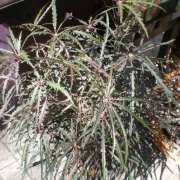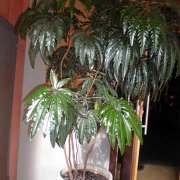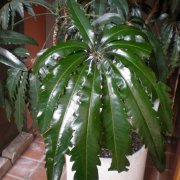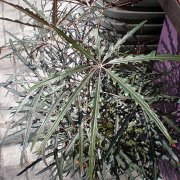Care of the indoor plant Dizygotheca elegantissima or False aralia |
|
Dizygotheca elegantissima is now classified as Plerandra elegantissima. The genus Plerandra, family Araliaceae, includes 50 species of trees and shrubs native to New Caledonia, Fiji, and Vanuatu. Some species are: Plerandra elegantissima, Plerandra nono, Plerandra actinostigma, Plerandra veitchii. Common names: False aralia, Spider aralia, Threadleaf aralia. Scientific synonym: Schefflera elegantissima. This species is native to New Caledonia. They are evergreen shrubs of elegant bearing that reach 1.5 meters (4.92 feet) in height indoors and 7 meters (22.96 feet) in height in their natural environment (they adopt an arboreal appearance). The alternate leaves have long petioles and are divided into long narrow leaflets (up to 8 cm/3.14" in length) with a toothed margin; the leaves are coppery when they sprout and then turn dark green. They do not usually bloom. They are used as indoor plants, greenhouse plants and on patios and terraces. In regions with a tropical or subtropical climate they are used as isolated specimens and in small shrub groups. Dizygotheca elegantissima needs a semi-shade exposure avoiding direct sun in the hottest hours of the day. They do not resist temperatures below 10 ºC (50 ºF). Avoid drafts and sudden changes in temperature. The soil must be well drained; use a mixture of heather soil, peat and coarse sand. Transplant every 2 years in spring, renewing the substrate. Water with lime-free water moderately, waiting for the substrate to dry. In winter, water very little. Periodically spray the leaves with lime-free water, especially in summer; They need a medium-high humidity. Fertilize every 3 weeks with mineral fertilizer from mid-spring to mid-summer. They are quite resistant plants to the usual pests and diseases. The leaves turn yellow if the humidity is low. The accumulation of water in the roots can cause them to rot. They are propagated by cuttings and from seeds but they are complicated processes. |
Images of the indoor plant Dizygotheca elegantissima or False aralia |
Find plants
Dizygotheca elegantissima or False aralia | Care and Growing
© 2024 FavThemes



